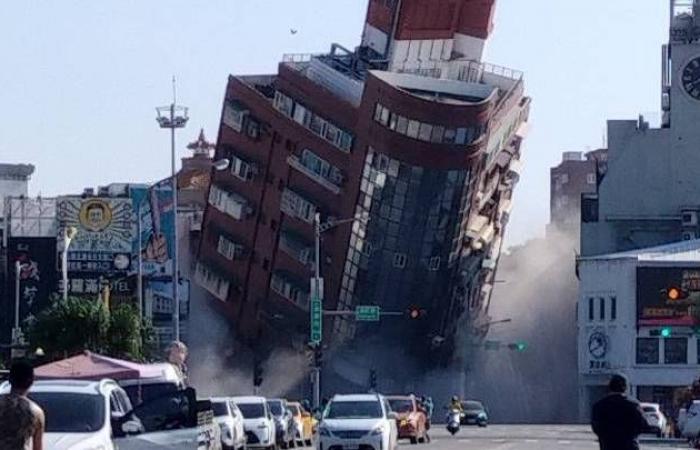Taiwan was hit this Wednesday (3) by strongest earthquake in 25 years. At least nine people died and 900 were injured. Buildings and highways were damaged and train service was disrupted.
But for the size of the earthquake, 7.4 on the Richter scale, which goes up to 10, the number of victims is considered low — even more so on an island with 23 million people and a very high concentration of tall buildings and many residents.
Earthquakes are not new to Taiwan: the island is hit by dozens of tremors a year. Most do not exceed 5 degrees on the Richter scale, but a dozen of them reach 6 or 7.
But its impact on the island’s 23 million people has been relatively contained thanks to its excellent earthquake preparedness, according to experts.
Why so many tremors?
Many deadly earthquakes have hit Taiwan in the past century. The island is located on several active faults, which are associated with seismic activity. Taiwan lies along the Pacific “Ring of Fire,” the line of seismic faults encircling the Pacific Ocean where most of the world’s earthquakes occur.
The area is particularly vulnerable to tremors due to tension built up by the interactions of two tectonic plates, the Philippine Sea plate and the Eurasian plate, which can lead to sudden releases in the form of earthquakes.
The region’s mountainous landscape can amplify ground shaking, leading to landslides. Several such landslides occurred on the east coast of Taiwan, near the epicenter of Wednesday’s earthquake near eastern Hualien County, when falling debris hit tunnels and highways, crushing vehicles and causing several deaths.
Why is Taiwan so well prepared to deal with earthquakes?
Taiwan has improved its level of preparedness over decades of suffering from destructive earthquakes. Since the 1980s, the country has improved its early warning system – to warn the population about earthquakes.
But after two landmark earthquakes the country revised its construction laws to prevent tragedies. A magnitude 76 earthquake in central Taiwan killed nearly 2,500 people in September 1999.
The earthquake, which struck about 90 miles south-southwest of Taipei, was the second deadliest in the island’s history. More than 10,000 people were injured and more than 100,000 homes were destroyed or damaged.
The country then undertook a lengthy review of its building and enforcement codes, requiring owners of vulnerable structures to install reinforcements, and requiring new buildings to have a strict earthquake safety system. Taiwan has created an urban search and rescue team and opened several emergency medical operations centers.
In 2016, a 6.4 magnitude earthquake caused a 17-story apartment complex to collapse in southwestern Taiwan, killing at least 114 people. The government then ordered a wave of building inspections, which have to be carried out every two years, to avoid tragedies.
Wednesday’s earthquake was 7.2, according to Taiwan’s earthquake monitoring agency, while the US Geological Survey rated it at 7.4. The earthquake damaged several buildings in Hualien, but caused only minor losses in the capital Taipei, despite being strongly felt there.
The earthquake occurred in the middle of the morning rush hour, but only slightly disrupted regular commuting. A few minutes later, parents were again taking their children to school and workers were driving to offices.
“Taiwan’s earthquake preparedness is among the most advanced in the world,” Stephen Gao, a seismologist and professor at the Missouri University of Science and Technology, told the Associated Press.
“The island has implemented strict building codes, a world-class seismological network, and widespread public education campaigns on earthquake safety.”
The government continually reviews the level of earthquake resistance required of new and existing buildings—which can increase construction costs—and offers subsidies to residents willing to check the earthquake resistance of their buildings.
Following a 2016 earthquake in Tainan, on the southwest coast of the island, five people involved in the construction of a 17-story apartment building, which was the only major structure that collapsed, killing dozens of people, were found guilty of negligence and sentenced to prison.
Taiwan is also promoting earthquake drills in schools and workplaces, while public media and cell phones regularly broadcast warnings about earthquakes and safety.
“These measures have significantly increased Taiwan’s resistance to earthquakes, helping to mitigate the potential for catastrophic damage and loss of life,” Gao said.
Living with earthquakes
Taiwan and surrounding maritime waters have recorded about 2,000 earthquakes with a magnitude of 4.0 or greater since 1980 and more than 100 earthquakes with a magnitude above 5.5, according to the USGS.
The island’s worst earthquake in recent years occurred on September 21, 1999, with a magnitude of 7.7. It caused 2,400 deaths, injured nearly 100,000 people and destroyed thousands of buildings.
The last deadly earthquake to hit Hualien County occurred in 2018, collapsing a historic hotel and other buildings.
“Unfortunately, this high level of seismic activity will continue for millions of years,” Gao said. “This highlights the importance of preparedness and resilience in the face of ongoing seismic risks.”






